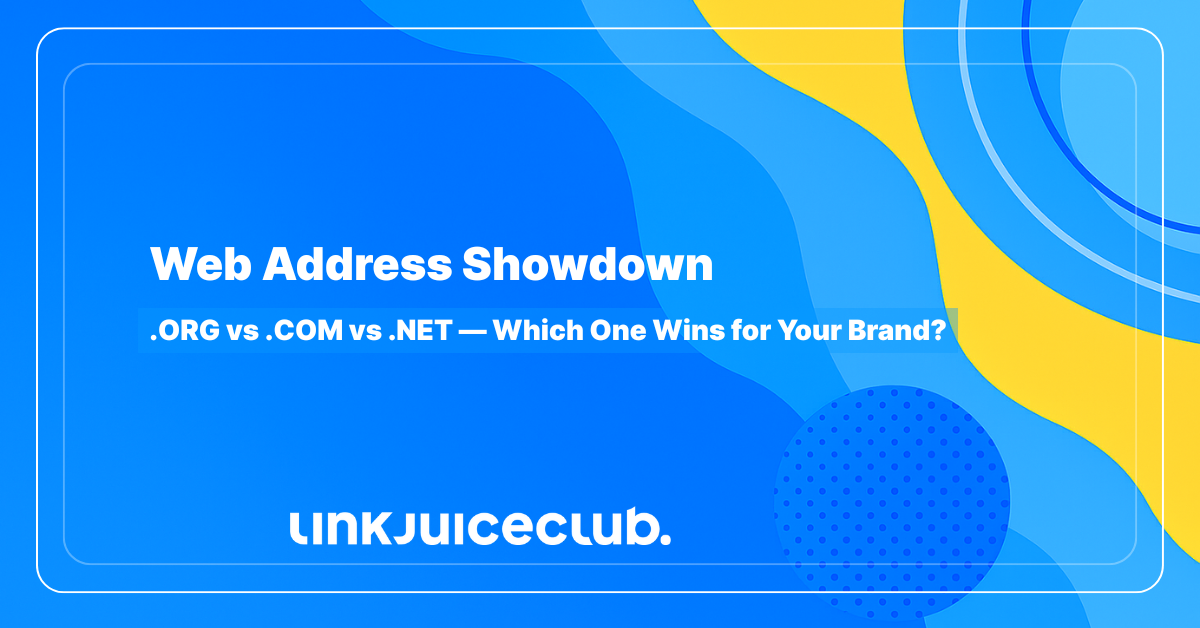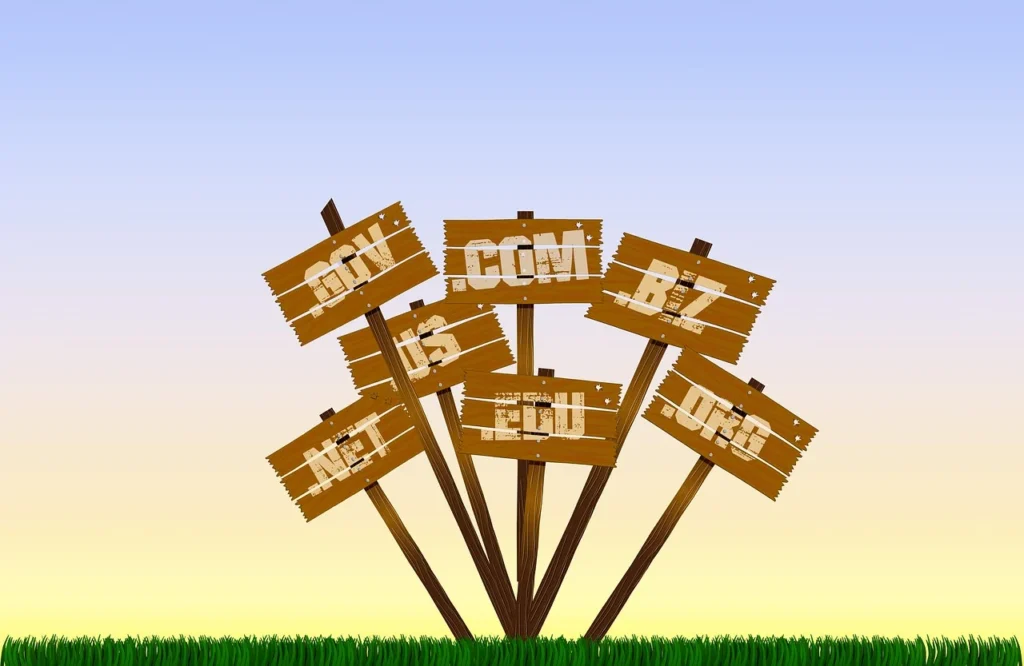
Web Address Showdown: .ORG vs .COM vs .NET — Which One Wins for Your Brand?
Choosing the right web address is like picking a digital suit — it needs to fit your brand, your mission, and your future vision.
But here’s the twist: it’s not just the name that matters.
Behind every web address lies a tiny cluster of letters — .com, .org, .net — that silently shape your site’s identity, trustworthiness, and even search visibility.
These aren’t just decorative dots. They’re called top-level domains (TLDs), and they:
- 📌 Signal what kind of site you run — business, nonprofit, network, or something else entirely
- 🌍 Help search engines and users understand your niche and location
- 🔁 Connect your site to the Domain Name System, translating it into something humans can remember and search engines can track
Sure, you’ve seen these extensions everywhere. But knowing when to choose .org, .com, or .net? That’s where strategy kicks in.

Let’s break them down and find the one that earns your clicks and your credibility.
TL;DR: .org vs .com vs .net — Quick Snapshot
Your web address—especially the domain extension—speaks volumes about your brand personality and credibility. This guide dives into:
- What each extension signifies
- When to use them to boost trust and visibility
- SEO considerations, user expectations, and strategic fit
Whether you’re launching a nonprofit, scaling a service-based business, or building a tech platform, this is the playbook for making a smart choice.
What .com Really Means
.com stands for commercial, originally reserved for business ventures. These days it’s the go-to for virtually any professional website, trusted globally.
Why .com Still Works Best
- 🌍 Nearly half of all websites use .com—making it the easiest to remember
- ⌨️ Mobile keyboards often auto-suggest .com, giving it a subtle edge
- 🧠 Consumers instinctively default to .com if unsure—so deviation risks losing traffic
When to Prioritize .com
- You plan to build a business or service-based venture
- You need broad recognition and instant credibility
- You want to minimize misdirected traffic from wrong extensions
💣 Pro Tip: Brainstorm domain names with .com availability early, even before finalizing your brand name.
What’s Behind .org?
.org stands for organization, created in 1985 for nonprofits, open-source projects, charities, and educational players. That legacy still carries weight.
Public Perception Matters
- 💬 People automatically assume a .org means nonprofit status
- Businesses using .org must clarify their structure to avoid confusion or backlash
- After deregulation in 2019, companies technically can register .org, but perception lags reality
Use .org If You’re:
- A bona fide nonprofit, NGO, or philanthropic initiative
- Building an audience motivated by mission and trust
- Hosting projects tied to education or public benefit
🚫 Common Mistake: For‑profit brands choosing .org without clarifying their status can undercut brand trust.
.org vs .com vs .net: Head-to-Head
| Extension | Best For | Pros | Cons |
| .com | Commercial ventures | Memorability, trust, default user choice | High competition, often unavailable |
| .org | Nonprofits & mission-driven sites | Credibility, clarity of purpose | Misinterpretation if used by businesses |
| .net | Tech, networking, remnant option | Viable backup option when .com/.org taken | Not as intuitive for general users |
How to Choose the Right Web Address
Choosing a domain extension isn’t just a box to check — it’s the starting line for your brand’s digital journey.
Get it right, and your web address becomes a trust signal, a memory hook, and a growth engine all rolled into one. Get it wrong, and you risk confusion, credibility hits, and lost clicks.

Here’s how to make sure your choice aligns with your mission and makes sense to your audience.
Step-by-Step Selection Guide
- Define the nature of your project
- Is it mission-driven or profit-driven?
- Is it mission-driven or profit-driven?
- Test domain availability early
- Check .com, .org, and .net
- Check .com, .org, and .net
- Consider audience expectations
- Who are your users, and what will they assume?
- Who are your users, and what will they assume?
- Plan how to manage perceptions
- If using .org as a business, include clear disclaimers
- If using .org as a business, include clear disclaimers
- Executive decision: pick the best aligning TLD
- If available, .com rules. If you’re nonprofit–lean .org. Otherwise, .net works.
- If available, .com rules. If you’re nonprofit–lean .org. Otherwise, .net works.
💣 Pro Tip: Run user tests—ask people to type or guess your site name. Notice what extension they select.
What Does .net Really Mean?
A lesser-known powerhouse, the .net extension is like the understudy that’s always ready to shine when .com takes center stage.
While only around 4% of websites globally use it, the .net top-level domain holds unique value—especially for businesses tied to infrastructure, tech, and networking.
The Origins and Modern Use of .net
The .net domain was born from the word “network”. It was created for umbrella-style websites—central hubs managing connected sites or services.
Fast forward to today, and .net is a top choice for:
- Internet service providers
- Hosting platforms
- SaaS tools, databases, and dev platforms
- Tech-driven startups looking for clean, scalable branding
💡 Example: A platform offering cloud storage and data collaboration might lean into a name like DataStream.net—modern, sleek, and brandable.
When to Choose a .net Web Address
You should consider a .net web address when:
- Your business provides tech or digital infrastructure services
- You want to maintain brand continuity, and .com is taken
- You need a domain that aligns with innovation and scalability
🚨 Important: If your desired .com version is owned by someone in a similar industry, skip .net. You’ll risk losing traffic—or worse, sending it to your competitor.
Instead, look for expired .com domains or try modifying your name creatively.
Build Brand Recall Around .net
Let’s be real—people are trained to type .com without thinking.
So, if you’re choosing .net, you have to own it in your branding:
- Weave the full domain into your logo or tagline
- Reinforce it in social handles and email signatures
- Say it out loud often: “Visit us at Upstream dot net”
That subtle repetition builds recall and avoids misdirected clicks.
.net vs .com — Which Web Address Wins?
There’s no one-size-fits-all answer. The best domain extension depends on your mission, your market, and your message.
Here’s what you need to know before choosing:
Intent & Industry First
- .com is designed for commerce, broadly interpreted
- .net suits businesses offering networked or digital services
✅ If you’re launching an eCommerce store, a blog, or digital product—.com still holds the crown.
✅ If you’re powering the tools behind those platforms—.net may actually serve you better.
Modern Usage Blurs the Lines
In practice, the strict definitions have faded. What really matters now?
- Whether users remember your web address
- How your domain fits your brand identity
- Whether it adds friction—or flow—to your user experience
🧠 Fun Fact: Some mobile devices favor .com with keyboard shortcuts—an edge worth noting for mobile-first businesses.
.org vs .com vs .net — The Big Picture
Now that we’ve explored each extension, how do they stack up side-by-side?
Think of this as your final clarity check before locking in that domain name.
| Extension | Best For | Trust Factor | SEO Impact | User Perception |
| .com | Commercial brands, eCommerce, blogs | ⭐⭐⭐⭐⭐ | Neutral | Universal and default |
| .org | Nonprofits, education, causes | ⭐⭐⭐⭐ | Neutral | Mission-driven |
| .net | Tech, hosting, SaaS, alt .com | ⭐⭐⭐ | Neutral | Functional, secondary |
Each web address tells a different story. What matters most is the story you want your domain to tell.
Domain Choice & SEO: The Real Impact on Rankings
It’s a common question in the SEO world: Does your domain extension affect your visibility on Google?
Here’s the honest truth — not directly. Choosing between .com, .net, or .org won’t inherently give your site a ranking boost. But your web address can still influence how discoverable, memorable, and accessible your brand is online.
Let’s unpack why that matters.
The UX Factor — And Why Mobile Is King
Most smartphone keyboards come preloaded with a .com shortcut. That means typing in a .net or .org requires extra taps, which might seem minor—but adds friction.
📱 With over 50% of global web traffic coming from mobile, this tiny UX detail can:
- Reduce repeat visits if users mistype or misremember your domain
- Increase bounce rates from frustrated mobile users
- Create confusion if a similarly named .com site exists
In the world of SEO, where dwell time and user experience matter, that micro-interaction can ripple into your engagement metrics.
Protecting Your Traffic & Reputation
💡 Smart strategy: Own both .com and .net versions of your domain when possible.
For $8–$20 per year, securing a second domain and redirecting it to your primary site is an easy win. It:
- Prevents competitors or squatters from claiming similar names
- Reduces traffic loss from user typos
- Protects your brand across platforms and geographies
Think of it as buying digital insurance for your brand’s discoverability.
Domain Extensions & Global SEO Strategy
Your choice of domain can also shape your reach internationally. Here’s how:
- Local SEO: If you’re targeting a specific country, a ccTLD (like .co.uk or .de) sends a strong local signal to Google
- Global brands: .com carries universal recognition — making it ideal for multinational businesses
- Niche appeal: .org and .net can suggest specific functions, aligning with nonprofit or tech-centric branding
While the extension doesn’t rank you higher, it frames expectations for both users and search engines.
🌎 Want to go global? Pair a .com with hreflang tags and subdirectories for multi-language targeting.
Think Like a User, Not an Algorithm
SEO isn’t just about satisfying Google’s crawlers — it’s about delivering a clean, trustworthy experience to real people.
So, while your web address won’t push you up the rankings by itself, it:
- Shapes user trust
- Influences click-through rates from search
- Supports broader brand recall
Bottom line? Choose the domain that aligns with your audience, device habits, and long-term branding goals — and then build SEO magic on top of it.
Choosing Your Domain: Set the Stage for a Strong Online Identity
Those three little letters at the end of your web address? They carry more weight than most people realize.
They don’t just tell search engines how to route your content — they tell visitors who you are, what you stand for, and why they should trust you.
Start with Strategy, Not Just Availability
Before you pick colors or write your first blog post, lock in a domain name and extension that align with your brand’s goals.
Here’s why:
- A smart domain choice reinforces brand trust from day one
- Early selection ensures consistency across web, email, and socials
- It sets you up to scale — locally, globally, or by niche
✅ Action Step: Choose your domain extension at the same time you build your brand identity — not as an afterthought.
Connect Brand, Mission, and Domain
Now that you understand the real-world roles of .com, .org, and .net, you’ve got the tools to make an informed decision.
Ask yourself:
- What’s the core purpose of your site?
- Who is your target audience, and what do they expect?
- Do you need broad appeal or niche credibility?
Your web address should reflect your voice, your value, and your vision — all in a few characters.
The Future of Domain Extensions: What’s Trending in 2025
Your web address isn’t just about where your site lives — it’s a digital handshake, a first impression, and a branding tool all in one. And as the internet evolves, so does the domain landscape.

Let’s look at where domain trends are heading in 2025 and how they might shape your next move.
Who’s Still Leading the Pack?
Despite rising competition, the classic extensions are still going strong:
- .com remains the most used domain worldwide, with nearly half of all global registrations
- .org holds its ground, especially among nonprofits and mission-led platforms
- .net continues as a solid fallback for tech-based services and brands
Also among the global top contenders:
- .de (Germany)
- .ru (Russia)
- .br (Brazil)
- .uk, .fr, .jp, and .it continue to rank within the top 10 extensions globally
These trends show no signs of fading — but the space is definitely widening.
Rising Alternatives & Newcomers in 2025
The classics still dominate, but fresh contenders are shaking up the domain scene. These newer top-level domains (TLDs) aren’t just trendy — they’re strategic tools for standing out in a crowded digital space.
Let’s explore the breakout stars making headlines and registrations in 2025.
The Rise of AI and Tech-First Extensions
- The .ai domain, originally a country code for Anguilla, has exploded in popularity thanks to the artificial intelligence boom
- It now sees over 20,000 new registrations per month, driven by startups and tech innovators
- Recognized by search engines as a generic TLD, .ai adds credibility and modern relevance to digital brands
Fast-Growing New gTLDs
New generic top-level domains (gTLDs) are also gaining traction:
- .xyz has surged to over 3.8 million registrations, making it the most popular new TLD
- .online and .top follow closely, praised for their versatility and international appeal
- The momentum is expected to grow with the next ICANN new gTLD round launching in 2026, introducing more diverse, language-inclusive options
Local and Industry-Specific Extensions
As the web grows more personal and localized, domain strategies are evolving too. Whether you’re targeting a country, a community, or a niche market, these specialized domain extensions offer clarity, relevance, and trust — all at first glance.
Here’s how regional and vertical-focused TLDs are rewriting the rulebook.
ccTLDs and Regional Identity
Country-specific domains like .de, .co, and .au are thriving due to strong local trust and SEO relevance:
- These extensions help brands appear more credible within their target regions
- Many countries have seen consumers prefer — or even demand — localized domains for trust and familiarity
- ccTLDs now play a central role in geo-targeted SEO strategies
Niches Get Their Own TLDs
As the digital space fragments, niche extensions are growing:
- Industry-focused domains like .shop, .design, .health, .finance, and .studio allow businesses to highlight their specialty
- Personal branding extensions like .me, .bio, and .fans are embraced by influencers, creators, and consultants
- Other trending choices include .blog, .live, .wiki, .center, .fun, .space, .ch, and .yoga
These extensions help sites stand out, create instant context, and connect with specific audiences faster.
Positioning Your Web Address for the Future
As competition for the best domains increases, and more people build personal brands or launch digital businesses, the value of choosing the right web address will only grow.
Here’s what 2025 tells us:
- Stick with .com for universal recognition and trust
- Use .org when your mission or message is purpose-led
- Lean on .net or .ai if you’re in tech or need a flexible alternative
- Don’t shy away from newer TLDs if they clarify your niche and add brand flavor
- Secure multiple versions of your domain when possible — and build your branding around it
Future-proofing your domain strategy isn’t just smart — it’s essential.
Smart Moves: 6 Pro Tips for Picking the Perfect Domain Extension
Choosing the right domain extension isn’t just about what’s available — it’s about sending the right signal at the right time. Your web address has the power to shape trust, reinforce purpose, and even steer your brand’s future.
Here’s how to make the smartest possible call:
1. Go Classic to Build Instant Trust
If you’re aiming for broad appeal and instant legitimacy, .com is still king. It’s familiar, professional, and baked into user behavior.
- Trusted by default
- Recognized globally
- Less room for second-guessing or mistypes
💡 Ideal for: startups, consultants, eCommerce, blogs, and general business use.
2. Let Your Mission Shape the Extension
Your domain should reflect your identity.
- Running a nonprofit, advocacy group, or open-source project? Go with .org
- Launching a tech platform or digital tool? Consider .net or .ai
- Building a personal brand? Try .me, .bio, or .name
Your extension is part of your pitch — make it align with your message.
3. Can’t Get the .com? Outsmart the System
So your dream .com is taken. Don’t panic — pivot.
- Use credible alternatives like .net, .co, or .io
- Choose a domain hack (e.g. “del.icio.us”) or add relevant keywords
- Make the extension part of your brand: “Streamline.tech” > “Streamlinetech.com”
🚫 Common Mistake: Settling for a weird, overly long .com just because it’s available. Clarity beats conformity.
4. Think Global? Or Go Local?
Where your audience lives should influence your domain.
- For worldwide reach, stick with generic TLDs like .com or .org
- For local trust and SEO perks, use ccTLDs like .uk, .ca, .au, or .de
- Bonus: Some ccTLDs double as brandable assets — .tv, .fm, .ai
Local domains speak your audience’s language — sometimes literally.
5. Simplicity = Recall
A domain should be easy to say, spell, and share.
- Avoid hyphens, numbers, and odd spellings
- Shorter names are easier to remember and less prone to typos
- Make it phone-call friendly: if you had to say your domain out loud, would someone spell it correctly?
The smoother your domain sounds and looks, the stronger the brand stickiness.
6. Plan for Growth, Not Just the Now
Even if you’re launching small, think big.
- Want to go commercial later? Consider .com for scalability
- Want room to pivot? Avoid overly specific or novelty extensions
- Secure multiple versions (.com, .net) to protect your brand long term
🛡️ Pro Move: Redirect backup domains to your main site — no traffic left behind.
The Bottom Line: Choosing a Domain Extension That Powers Your Growth
Your web address isn’t just a technical detail — it’s a strategic asset. Whether you go with a timeless .com, a purpose-driven .org, a tech-savvy .net, or a rising-star extension like .ai, your domain shapes how people perceive, find, and remember your brand.
Let’s recap the essentials:
- .com is still the global gold standard — familiar, trusted, and ideal for most business types
- .org brings mission-focused credibility — best suited for nonprofits, education, and causes
- .net offers a strong alternative — especially for infrastructure, hosting, and digital services
- New and niche TLDs like .shop, .bio, or .design help clarify your focus and stand out
- Country-specific domains boost trust and visibility in local markets
- Your domain extension should reflect your purpose, audience, and expansion plans
But don’t stop at picking the right domain — use it to fuel your long-term growth.
🔧 Build an SEO foundation that aligns with your extension’s message
🤖 Use AI-powered link building tools to find relevant backlink opportunities across domains with similar TLDs (e.g., .org to .org)
🔗 Combine domain strategy with content, technical SEO, and branded outreach to increase discoverability and authority
📈 Treat your domain as a growth lever — the right TLD, backed by the right strategy, sets your site up for scale
Your domain isn’t just where you live online — it’s where your brand story begins.
So pick smart. Brand boldly. And use every piece of your web presence — including that final dot and what follows — to move your mission forward.





